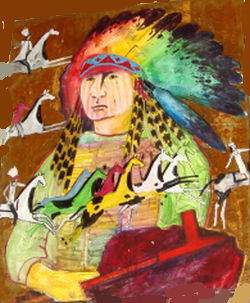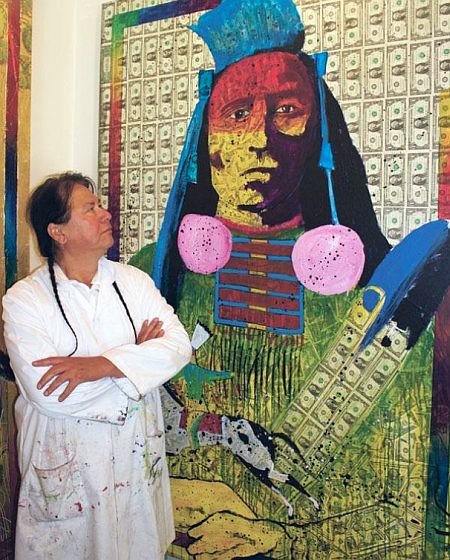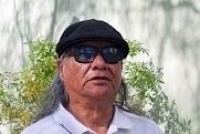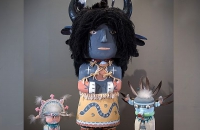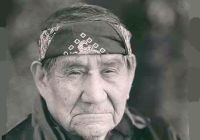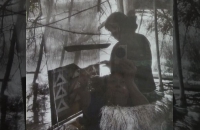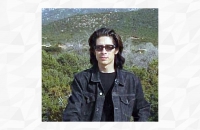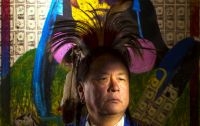A475 Stan Natchez -- “Chief With Many Horses” is a mixed Medium original painting by Shoshone/Paiute artist Stan Natchez. The 24 x 30 painting on canvas has a gold leaf background.
Call for shipping
Many Horses was a holy man of the Oglala Lakota tribe. He was a friend of Sitting Bull and a believer in the Ghost Dance. In the spring of 1890, he organized a Ghost Dance ritual at Standing Rock Reservation to drive away the white soldiers camped nearby, but was distressed to see that they were still there at dawn the next day. He then said to the assembled people: "I will follow the white man's trail. I will make him my friend, but I will not bend my back to his burdens. I will be cunning as a coyote. I will ask him to help me understand his ways, then I will prepare the way for my children, and their children. The Great Spirit has shown me - a day will come when they will outrun the white man in his own shoes."
Natchez takes on subjects with anger potential but portrays them with humor and a painterly finesse. When he was a child, his grandmother schooled him in the traditional beadwork that adorns dance costumes and taught him to hold bitterness and hatred as a disease.
About the artist
Stan Natchez
(Shoshone-Tataviam or Paiute b. 1954 – present)
Stan Natchez is known for his innovative and creative paintings. Inspired by Andy Warhol, Jasper Johns, T.C. Cannon and other pop artists, his paintings exude the power of color and familiar objects. His canvases often begin with artifacts of American culture that either directly or indirectly reflect Indians. He then includes figures such as Native Americans, mission priests or cowboys. Intricate "stars and stripes" beadwork add texture to bold works that emanate beauty and joy. Dollar bills are layered on the canvas as a modern-day buffalo hide.
In addition to being a nationally known artist, Natchez has distinguished himself as a graduate student, teacher, dancer, editorial advisor, and legal advocate for the native American community. As a traditional dancer who performed in European capitals as well as throughout the United States, Natchez developed a fine eye for both color and composition from the beadwork he created for his regalia. He also credits dance as a medium for building a stronger sense of cultural self-esteem.
Having earned a Bachelor of Science degree at the University of Southern Colorado (Education) and a Master of Fine Arts (Curriculum) at Arizona State University, Stan Natchez has always been an educator, and a student of the world. Former Humanities Department Chairman at Arizona's Orme School, he has also taught art in several public schools. He was Editorial Advisor and Education Coordinator for the Native Peoples Magazine. In addition to being an artist, Mr. Natchez is a legal advocate for the Native American community.
In terms of his art, Natchez feels strongly about communicating contemporary Native American philosophy that has been purged of any romantic or stereotypical idealism. He says, "I paint the life I live and so every painting, in some way, is a self-portrait. My art is about you and the way I respond. that is my experience...my experience is my art...and art is my life.
"I feel fortunate for having been raised in the city because of the perspective it game me on modern life. However, without an awareness of our traditional heritage, we as Native Americans have no identity. By taking the best of both worlds, the modern and the traditional, we are better able to find balance in our lives."
Museum Collection
Boston Fine Arts Museum
Santa Fe Fine Arts Museum
Booth Western Art Museum
Albuquerque Fine Arts Museum
Smithsonian Institute
Autry Museum of Western Art
Selected Publications
Winchell, Katie, "Balancing Two Worlds," Whole Life Times, Los Angeles, CA, September 2004
DeLeon,Yadhira, "The Art of Stan Natchez."LatinoLA, Los Angeles, CA, June 2004
Deats, Suzanna, "I Paint the Life I Live," Focus/Santa Fe, Santa Fe, NM, January - March 2001
Sandoval, Aubrey, "On the Money", Santa Fe New Mexican, July 27, 2001
Zatecky, Lorenz, Meeting on a Bridge: Stan Natchez, Shoshoni/Tataviam, Munich: Bachmaier, 1998

